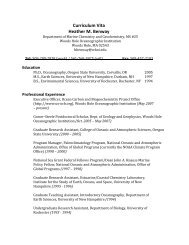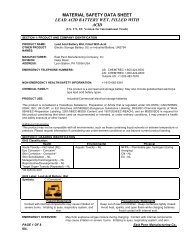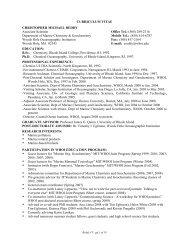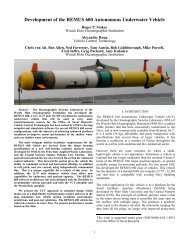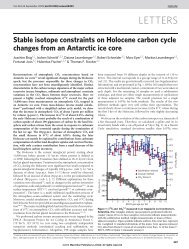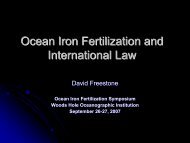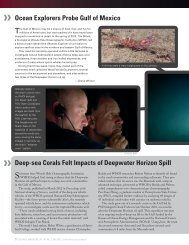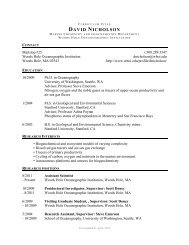Seafloor Seismometers Monitor Northern Cascadia Earthquakes
Seafloor Seismometers Monitor Northern Cascadia Earthquakes
Seafloor Seismometers Monitor Northern Cascadia Earthquakes
Create successful ePaper yourself
Turn your PDF publications into a flip-book with our unique Google optimized e-Paper software.
EOS, TranSacTiOnS, amErican GEOphySical UniOn<br />
The M w = 9.0 earthquake of 11 March 2011<br />
at the Japan Trench and its devastating tsunami<br />
underscore the importance of understanding<br />
seismogenic behavior of subduction<br />
faults and realistically estimating the potential<br />
size of future earthquakes and tsunamis.<br />
For the <strong>Cascadia</strong> subduction zone (Figure<br />
1a), a critical knowledge gap is the level<br />
of microseismicity offshore, especially near<br />
the megathrust, needed to better understand<br />
the state of the locked zone. In 2010 the first<br />
detailed seafloor earthquake monitoring campaign<br />
along the northern <strong>Cascadia</strong> subduction<br />
zone recorded nearby earthquakes in the<br />
local magnitude (M L ) range from possibly<br />
around zero to 3.8 (Figures 1b and 1c) and<br />
larger earthquakes from outside this region.<br />
Preliminary analyses indicate that the network<br />
appears to have yielded a fairly complete<br />
catalog for events with M L > 1.2. Only<br />
a few tens of these events occurred beneath<br />
the continental shelf and slope (Figure 1a).<br />
The majority of the earthquakes were located<br />
along the margin- perpendicular Nootka fault<br />
zone. The relatively low seismicity away from<br />
the Nootka fault is consistent with a fully<br />
locked megathrust. Land-based GPS measurements<br />
cannot resolve the question of<br />
whether the offshore part of the megathrust<br />
seismogenic zone is narrow and fully locked<br />
or wider and only partially locked (slowly<br />
creeping). If it were only partially locked, the<br />
seafloor seismometer data should show many<br />
more small earthquakes along the interface<br />
than were actually detected.<br />
The SeaJade Project<br />
The <strong>Seafloor</strong> Earthquake Array– Japan-<br />
Canada <strong>Cascadia</strong> Experiment (SeaJade)<br />
is a multiyear, two-phase collaboration<br />
involving the Japan Agency for Marine-<br />
Earth Science and Technology (JAMSTEC),<br />
University of Victoria, Geological Survey<br />
of Canada (GSC), and Woods Hole Oceanographic<br />
Institution (WHOI). The first<br />
phase of SeaJade consists of the successful<br />
deployment of 32 short-period ocean bottom<br />
seismometers (OBSs) from JAMSTEC<br />
and 10 broadband instruments from WHOI,<br />
plus the use of the permanent broadband<br />
Eos, Vol. 92, No. 47, 22 November 2011<br />
<strong>Seafloor</strong> <strong>Seismometers</strong> <strong>Monitor</strong><br />
<strong>Northern</strong> <strong>Cascadia</strong> <strong>Earthquakes</strong><br />
PAGES 421–422<br />
seismometers of the North-East Pacific<br />
Time-series Undersea Networked Experiments<br />
(NEPTUNE) Canada cabled seafloor<br />
Volume 92 number 47<br />
22 noVember 2011<br />
pages 421–440<br />
observatory (http:// www . neptunecanada<br />
.ca).<br />
The array is located mostly on the continental<br />
slope (Figure 1a). The short-period OBSs<br />
detected more than 1500 earthquakes from<br />
July to October 2010. Data from the broadband<br />
OBSs, deployed from July 2010 to July 2011, are<br />
being processed. The next SeaJade deployment<br />
of OBSs is planned for 2013.<br />
Fig. 1. (a) Map showing the <strong>Seafloor</strong> Earthquake Array–Japan-Canada <strong>Cascadia</strong> Experiment<br />
(SeaJade) monitoring area at the northern <strong>Cascadia</strong> margin, seismometer stations at the seafloor<br />
and on Vancouver Island, and preliminary earthquake epicenters from the Japan Agency for<br />
Marine-Earth Science and Technology ( JAMSTEC) short-period ocean bottom seismometer (OBS)<br />
array. (b) Example of a small earthquake ( M L = 0.2) shown on the six JAMSTEC OBSs nearest<br />
this earthquake. (c) Example of a larger earthquake ( M L = 3.8) shown on all 32 JAMSTEC OBSs,<br />
the two North-East Pacific Time-series Undersea Networked Experiments (NEPTUNE) Canada<br />
(NC) OBSs located on the continental slope, and the three seismometers on Vancouver Island<br />
(VI) closest to this earthquake.
SeaJade Targets<br />
Future analyses in this project will include<br />
a comparative study of Japan’s Nankai subduction<br />
zone. The <strong>Cascadia</strong> margin is similar<br />
to Nankai in many ways, including the<br />
young age of the subducting plate, a moderate<br />
convergence rate, ample trench sediments, a<br />
large accretionary sediment prism, and the<br />
occurrence of episodic tremor and slip (ETS).<br />
A large amount of information has been gathered<br />
through OBS monitoring at Nankai, including<br />
numerous small earthquakes previously<br />
undetected by land-based networks, very low<br />
frequency (VLF) earthquakes likely occurring<br />
in the accretionary prism, and shallow subseafloor<br />
seismic tremor [e.g., Obana et al., 2006;<br />
Obana and Kodaira, 2009]. To better understand<br />
the seismogenic behavior of convergent<br />
margins, it is important to know whether similar<br />
phenomena are present at <strong>Cascadia</strong>.<br />
A clear difference between the <strong>Cascadia</strong><br />
and Nankai margins is that many more earthquakes,<br />
mainly in the downgoing plate, are<br />
recorded in similar monitoring campaigns<br />
at the fully locked Nankai subduction zone<br />
[e.g., Obana et al., 2006] than at <strong>Cascadia</strong>.<br />
This may reflect different states of stress<br />
relaxation due to the different elapsed times<br />
since the previous great earthquakes, which<br />
occurred only 6 decades ago at Nankai but<br />
3 centuries ago at <strong>Cascadia</strong>. This explanation<br />
is consistent with geodetically determined<br />
upper plate deformation where strain<br />
rates due to fault locking are larger at Nankai<br />
[Wang, 2007]. For understanding subduction<br />
earthquake processes, differences between<br />
the two margins are as important as their similarities.<br />
Another difference, not detailed in<br />
Eos, Vol. 92, No. 47, 22 November 2011<br />
this report, is the role of the Nootka fault as a<br />
major shear zone in the subducting plate.<br />
A fortuitous aspect of the first SeaJade<br />
deployment is that the August– September<br />
2010 <strong>Cascadia</strong> ETS occurred during the<br />
OBS recording. Although the ETS sources<br />
are landward of the locked seismogenic<br />
zone, a pertinent question is whether there<br />
are accompanying seismic signals offshore.<br />
Some tremor-like signals were noticed in the<br />
OBS records, but the nature of these signals<br />
requires more thorough analyses.<br />
On the <strong>Cascadia</strong> margin, there has not been<br />
an extensive search for VLF events and offshore<br />
tremor, although some evidence for a VLF event<br />
has been found using seismograms of the landbased<br />
network [Kao et al., 2008]. Detection of<br />
VLF events is a primary target in the analysis of<br />
the 10 broadband OBSs from WHOI.<br />
Several margin-wide deep seismic surveys<br />
and offshore drilling legs also contribute to<br />
the seismic characterization of the northern<br />
<strong>Cascadia</strong> margin. For example, a borehole<br />
observatory on the continental slope, newly<br />
installed under the Integrated Ocean Drilling<br />
Program and soon to be connected to<br />
NEPTUNE Canada, has enabled long-term<br />
monitoring of pore fluid pressure variations<br />
associated with seismic and aseismic strain<br />
[Davis and Petronotis, 2010]. An integrated<br />
analysis of events recorded by land-based<br />
networks, NEPTUNE Canada, and SeaJade<br />
will significantly improve understanding of<br />
seismicity in northern <strong>Cascadia</strong>.<br />
Acknowledgments<br />
This work is funded by JAMSTEC, the Natural<br />
Sciences and Engineering Research Council<br />
of Canada, GSC, and the U.S. National<br />
Science Foundation. The W. M. Keck Foundation<br />
funded the development of the WHOI<br />
instruments. Ship time and technical support<br />
were provided by GSC. Officers, crew, scientists,<br />
and technicians on the Canadian Coast<br />
Guard Ship John P. Tully for the SeaJade<br />
expedition are also gratefully acknowledged.<br />
References<br />
Davis, E. E., and K. E. Petronotis (2010), <strong>Cascadia</strong><br />
subduction zone ACORK observatory, IODP Sci.<br />
Prosp., 328, 73–84, doi:10.2204/iodp.sp.328.2010.<br />
Kao, H., S. Shan, H. Dragert, G. Rogers, and Y. Ito<br />
(2008), <strong>Northern</strong> <strong>Cascadia</strong> episodic tremor<br />
and slip: A decade of observations from 1997 to<br />
2007, Eos Trans. AGU, 89(53), Fall Meet. Suppl.,<br />
Abstract U31B-02.<br />
Obana, K., and S. Kodaira (2009), Low-frequency<br />
tremors associated with reverse faults in a shallow<br />
accretionary prism, Earth Planet. Sci. Lett.,<br />
287, 168–174, doi:10.1016/j.epsl.2009.08.005.<br />
Obana, K., S. Kodaira, and Y. Kaneda (2006),<br />
Seismicity related to heterogeneous structure<br />
along the western Nankai trough off Shikoku<br />
Island, Geophys. Res. Lett., 33, L23310,<br />
doi:10.1029/2006GL028179.<br />
Wang, K. (2007), Elastic and viscoelastic models<br />
of subduction earthquake cycles, in The Seismogenic<br />
Zone of Subduction Thrust Faults, edited by<br />
T. H. Dixon and J. C. Moore, pp. 540–575, Columbia<br />
Univ. Press, New York.<br />
—Martin Scherwath and GeorGe Spence,<br />
School of Earth and Ocean Sciences, University of<br />
Victoria, Victoria, British Columbia, Canada; E-mail:<br />
mscherwa@uvic.ca; Koichiro obana and Shuichi<br />
Kodaira, Institute for Research on Earth Evolution,<br />
JAMSTEC, Yokohama, Japan; Kelin wanG and<br />
Michael riedel, Natural Resources Canada, GSC<br />
Pacific Division, Sidney, British Columbia, Canada;<br />
and Jeff McGuire and John collinS, WHOI, Woods<br />
Hole, Mass.



